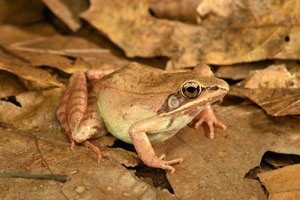
They weigh less than a pound, in most cases much less, and they make few sounds. Yet frogs, toads, salamanders, turtles, and snakes have a big presence in the landscape.
Part of their impact has to do with their diverse and interesting diets, according to environmental scientist and herpetologist Dennis Quinn from Plantsville. (www.CTHerpetology.com) Consider, for instance, that some are hungry for mosquitoes and others love to snack on tick-carrying rodents.
“Frogs and toads are critical in natural food chains,” Quinn says. “And, yes, they are predators of insects, but they are also prey for a variety of species.” (Owls, for instance, dine on these critters.) “Furthermore, at the larval stage, frogs feed on algae and help maintain water quality in the aquatic environments where they spawn.”
Frogs also alert us to contaminants. “As amphibians, frogs have permeable skin. This makes them great barometers of environmental quality, especially for the water we drink and air we breathe,” Quinn says.
Learn more about regional amphibians and reptiles. Read the full story at TheDay.com
